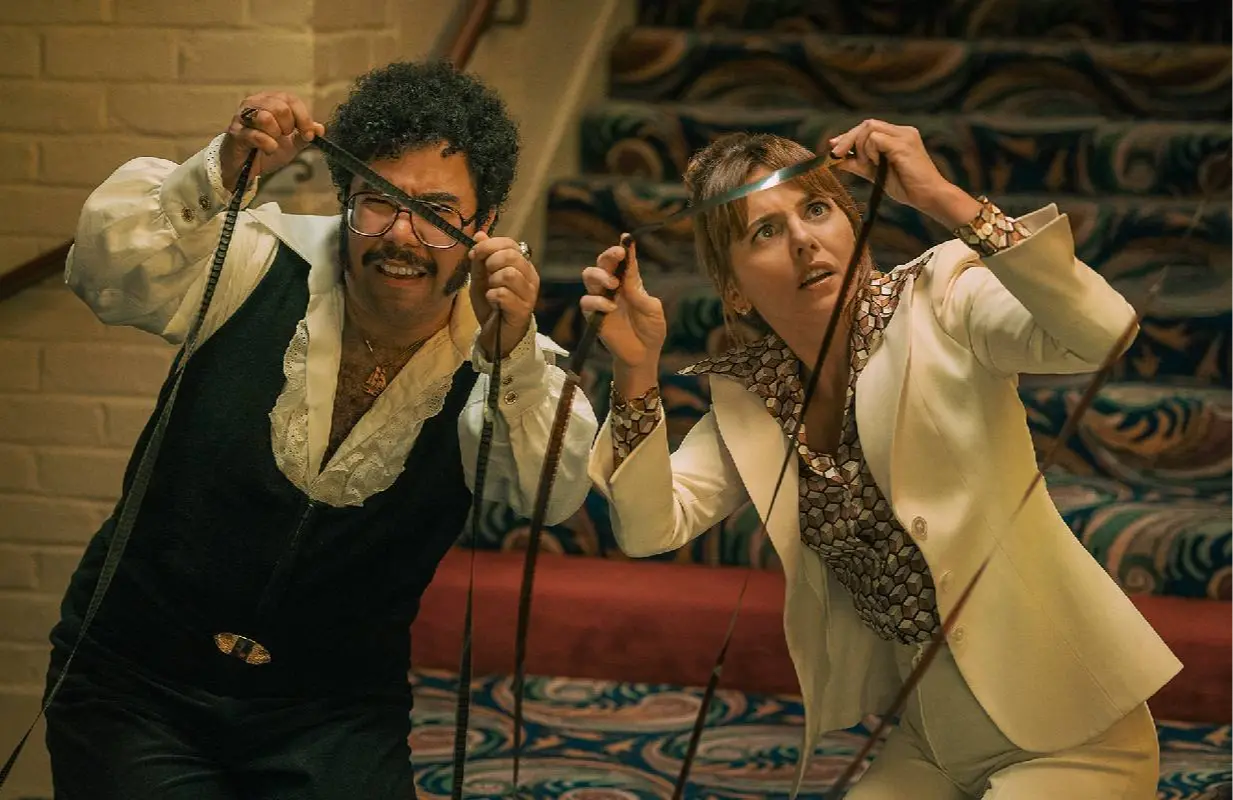Minx Deals With Performance Issues in Glossy Second Season
-
 Oscar Montoya and Ophelia Lovibond star in Minx (Photo: Starz)
Oscar Montoya and Ophelia Lovibond star in Minx (Photo: Starz)Second seasons are tough. Second seasons of a show that’s been axed by one network and saved by another are tougher, at least from a pressure standpoint. Enter Minx, the Ellen Rapoport-created comedy revolving around a fictional feminist magazine in the 1970s. The show was renewed then canceled over at HBO Max before Starz stepped in to save it. The question is, was it a show worth saving?
In the inaugural 10 episodes, Minx followed a self-proclaimed feminist named Joyce Prigger (Ophelia Lovibond) as she launched the female-forward magazine Minx with porn publisher Doug Renetti (Jake Johnson). They peppered the pages with phallus to lure women in, while spreading word about women’s rights through captivating copy. (Hey, if men read Playboy for the articles…)
Breathtaking sets and costumes aside, the sparring between Joyce and Doug as they found creative middle ground while cutting red tape and stomping out political fires was the reason to watch. Joyce, Doug and the Bottom Dollar publishing crew — Joyce’s sister Shelly (Lennon Parham), photographer Richie (Oscar Montoya), chief fun officer Bambi (Jessica Lowe), and Doug’s right-hand woman Tina (Idara Victor) — were underdogs. They fought for a common cause and watching them succeed then stumble in their mission for gender equality was fun.
When Season 2 picks up that struggle is long gone, and Minx feels like a different show. The magazine is now firmly under Joyce’s jurisdiction and every publisher in town is courting her. Fearful that commercial success may result in a loss of creative vision, Joyce ultimately returns to Doug and together they sell Bottom Dollar publishing to retired shipping magnate Constance Papadopolous (Elizabeth Perkins). Constance is one of Joyce’s feminist icons and she comes with a never-ending pool of cash, so the honeymoon is on.
At first, Constance brings an earlier perspective to the second-wave feminist movement, having fought her own battles before retirement. She’s a natural mentor for Joyce as she grooms her into the face of the cause, complete with fancy clothes and promises of global expansion. However, money talks, and Constance has her own ideas about the role Minx’s mainstream attention has in pushing feminism forward. As the eight-episode season progresses, her vision doesn’t always align with Joyce’s, recreating a little of that Season 1 tension. But maybe not enough of it to recapture the magic.
This is no longer a series about a magazine’s struggle for survival in a seedy environment, but a glossier update that questions how success forces you to evolve. Is it possible to carry forward with the same ideals when pursuing international editions? When you’re the face of a movement, how much do your actions matter? And what happens to the people who were there for you from the beginning?
As Joyce transforms into a celebrity of sorts, she absolutely forgets about that rag-tag team, which makes her harder to root for. That’s especially true in the moments between Joyce and Shelly, as the show digs into their relationship. As Shelly comes into her own there are several delightful scenes that showcase Parham’s commanding presence in all its glory, but they also paint Joyce as an anti-villain. That’s true of her relationship with nearly all of the Bottom Dollar members and it drives the band to break up. At one point Bambi, feeling uncertain about her future in it all, leans on Richie, her “family,” for support. “Not a family, just a workplace,” he retorts, steadfast.
It’s that tonal shift that dampens the spark from Season 1. As each character grows up and outwards they also grow apart, without that common fight to unite them. Even Doug, the wheeling-dealing powerhouse with a quick tongue is subdued in Season 2. He has comedic moments, in particular as he embraces his new gig as the head of merchandising, but he doesn’t quite know what to do with himself when he’s not fully in charge.
As for Tina, she seems to be the only character who handles the newfound success with aplomb, and viewers are given a better perspective into her psyche in Episode 6 when the show introduces her family and delves into her backstory. Still, you’re left wanting more.
Along the way there are some successes as the show volleys feminist issues that remain relevant today (women in sport, the practice of pitting successful women against one another), and that’s when Minx truly shines. Scenes between guest star Gillian Jacobs and Lovibond are particularly memorable. Unfortunately, with only eight episodes and multiple characters to service, those moments are scarcer than they should be and the overall delivery falls flat.
By the time Minx reaches its climax, there is promise of reuniting the missing motley crew, should a third season come to fruition. Until then, expect plenty of glossy costumes, sets and male genitalia packaging up those painful second-season growing pains.
Minx premieres Friday, July 21 at 9:00 PM ET on Starz. Join the discussion about the show in our forums.
Amber Dowling is a Toronto-based freelancer, CCA member and former TCA president. Her work has appeared in Variety, The Hollywood Reporter, Metacritic, The Globe and Mail, Playback and more. Follow her on Instagram: @amber__dowling.
TOPICS: Minx, Starz, Idara Victor, Jake Johnson, Jessica Lowe, Lennon Parham, Ophelia Lovibond, Oscar Montoya